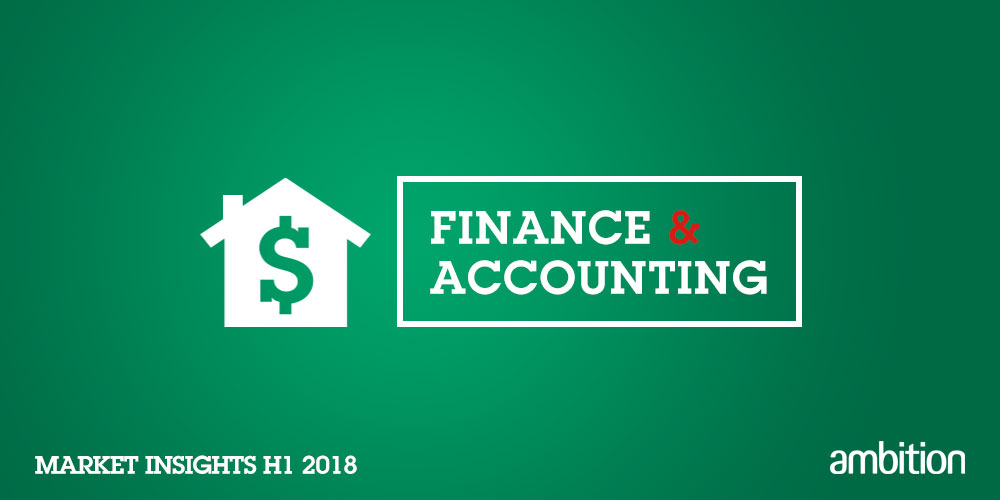Please beware of recruitment scams that are currently targeting jobseekers. Click here for further advice.

Finance & Accounting Market Insights H1 2018
The second half of 2017 has seen an increase in demand for finance professionals, particularly across financial planning and analysis (FP&A) and internal audit (IA) functions.
This demand has been led by the fact that organisations want to continue improving their finance business partnering functions to better support the growth of the business and also mitigate risk. This is not particular to one specific industry, but similar interest and demand have been seen across industries, from industrial to healthcare and education to digital.
The demand for IA professionals has largely been due to replacement needs. Strong IA roles were often challenging to source for due to the demand for travel, and for the same reason, the process has also often been lengthy. That said, there has been significant demand for these professionals and this is likely to continue across the Southeast Asia region.
Hybrid skillsets were in demand
In the past few months, another interesting and consistent development is the increase in the employer's demand for hybrid skillsets rather than traditional finance and accounting skills. This is largely due to the evolving market that is scaled towards digital, transformation and change.
Contract hires were on the rise
We also saw contracting requirements increasing, particularly across the healthcare, manufacturing, IT and media industries.
Typical contract roles in demand were across FP&A, financial management and controllership, and this was across multinationals (MNCs) and small-to-medium enterprises (SMEs), as organizations looked to adopt a more flexible workforce and get through year-end processes.
Looking ahead into the year 2018
In 2018, we expect the demand for finance and accounting talent to continue with similar trends seen in 2017.
Singapore still remains a strategic hub for Asia and APAC, and the demand for skilled workforce reflects this. The ongoing trend of transactional roles being offshored to lower cost locations is set to continue into the months ahead, and roles in the Lion City will tend to be reflective of a global strategic hub.
Finance & Accounting
Salary Report for H1 2018*
Commerce & Industry |
|
|
Job title | Years of experience | Annual salary range (S$) |
Audit / Internal Control | ||
Head of Audit | 12–15 | 180K–350K |
Senior Audit Manager | 8–10 | 130K–180K |
Internal Audit Manager | 5–8 | 90K–130K |
Internal Auditor | 3–5 | 50K–90K |
Financial Accounting | ||
CFO | 15+ | 250K–500K |
Finance Director | 12–15 | 200K–300K |
Regional Financial Controller | 10+ | 150K–250K |
Financial Controller | 8–10 | 120K–150K |
Finance / Accounting Manager | 6–10 | 80K–120K |
Financial Accountant | 3–6 | 50K–80K |
Accounts Payable / Accounts Receivable Accountant | Up to 8 years | 40K–60K |
Management Accounting | ||
Manager | 8–10 | 120K–180K |
Senior Management Accountant | 5–8 | 80K–100K |
Management Accountant | 3–5 | 50K–80K |
Planning & Analysis | ||
Head of Planning & Analysis | 10–12 | 140K–220K |
Financial Planning & Analysis | 8–10 | 80K–140K |
Senior Financial Analyst | 6–8 | 80K–120K |
Financial Analyst | 3–6 | 50K–80K |
Tax | ||
Vice President / Head of Tax / Tax Director | 12+ | 180K–350K |
Tax Director | 10+ | 200K–350K |
Tax Manager | 8–10 | 110K–200K |
Tax Accountant / Senior Accountant | 3–7 | 70K–110K |
Treasury | ||
Head of Treasury | 10–12 | 170K–350K |
Treasury Manager | 7–10 | 90K–170K |
Treasury Accountant | 3–6 | 50K–90K |
*Notes about salary table:
Titles and levels vary from organisation to organisation.
The salary ranges given are only approximate guides. For tailored salary advice, please contact us directly.
12-month base salaries are assumed.
All other benefits and bonuses are in addition to these figures.
Bonus ranges can vary significantly from company to company and will be influenced by market conditions, business and individual performances. Bonus ranges from 1 month at the low end to 100%+ at the upper.
Holiday entitlements range from 12–25 days with senior executives not usually receiving less than 18 days. Less than 15 is very rare and 20 days is becoming the norm.
Healthcare policies are standard.
Pension plans vary with some companies offering greater than the standard contribution. Top up schemes can increase employer contribution levels as much as 15–20% of the base salary for senior executives.
![[Blog] Lwa Prateek Jain (1)](https://image-assets.eu-2.volcanic.cloud/api/v1/assets/images/721eccab5052875d15185b20e1e18abd?size=480x500%3E)



![[Blog] Lwa Ern Chi Loy (2)](https://image-assets.eu-2.volcanic.cloud/api/v1/assets/images/b1f02cdf0e87fbb492b42779de42d975?size=480x500%3E)
![[Blog] Global Iwd Collage](https://image-assets.eu-2.volcanic.cloud/api/v1/assets/images/b8b528065422b3892cc7679748c7ffa4?size=480x500%3E)
![[Blog] 5 Strategies To Attract & Retain Finance & Accounting Talent In Singapore](https://image-assets.eu-2.volcanic.cloud/api/v1/assets/images/38badd1de52da89b5fa73aebe747532e?size=480x500%3E)
